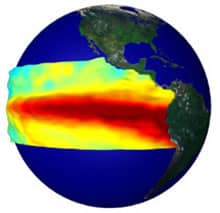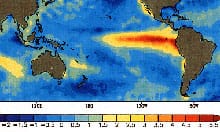El Nino. What is it?
El Niño and La Niña are opposite phases of what is referred to as the El Niño-Southern Oscillation (ENSO) cycle. This cycle is a a description of temperature fluctuations between the ocean and atmosphere in the east-central Pacific region. El Niño means The Little Boy in Spanish and is not a new phenomenon. It was originally recognised by South American fishermen in the 1600s, who noticed the unusually warm water in the Pacific Ocean. The name was chosen based on the associations of the term El Nino with the baby Jesus, since the warming tended to occur around December.

So where gets affected most?
From the image, you can see the areas most affected, with red being the highest temperature range. So you would expect this event to be felt anywhere in this region and possibly further out as the effect spreads. Most obviously in the firing line are the coastal regions of the south-west of the USA, and Pacific coastlines of Mexico, Central American and South American nations. Out in the Pacific itself islands in the area such as Galapagos and Cocos are obviously going to see some effects. Depending on the severity and duration of the warming event, effects may spread to islands and nations on the other side of the Pacific Ocean such as Fiji, Hawaii, the Solomon islands, Palau, Australia and Indonesia and to a lesser extent, worldwide.
Is the diving affected right now in world-class destinations?
We have been asked about El Niño by quite a few customers. So we put our feelers out to get a clearer picture of what was being experienced on the ground (or under the water). Below is some feedback from a variety of the places we have been asked about, by people with intimate knowledge of the diving in those places:
Galapagos Islands
Galapagos Sky: “We receive weekly reports back from our Captains and Dive Guides with water temperatures, water visibility and lists of the marine animals they encountered on their dives. While I am not a scientist, just a diver reading reports back from our dive guides, from our reports it appears that the water temperatures are warmer in the southern islands of Galapagos compared to 2014. The northern islands, Wolf and Darwin, have very little or no change from last year. When comparing animal encounters from November & December 2014 to November & December 2015, we are seeing very little or no change. Our divers are still having amazing dives and seeing all of amazing creatures of Galapagos.”
Cocos Island
Okeanos Aggressor I and II: “There is no doubt that El Niño has affected not only our area, but in general, the whole world, Europe and America for example are having super warm temperatures for this time of year.
 It is also true that not all weeks have had the same marine life or maybe they have been a little deeper and this year, in Cocos, we have had great diving weeks with all you can see, tiger sharks, hammerheads, whales, mantas you name it.
It is also true that not all weeks have had the same marine life or maybe they have been a little deeper and this year, in Cocos, we have had great diving weeks with all you can see, tiger sharks, hammerheads, whales, mantas you name it.
and also some weeks where the hammerhead schools were seen in less numbers of specimens but they have been constant all year around, as said, maybe not in huge number of sharks like when the water is colder, but it also happens between rainy season and dry season, or simply because that week hasn’t been that good. Having said that, in Cocos, we are lucky as when sharks are maybe not that present, we get manta rays or other kind of pelagic fish. For now, we have had a good diving year and hopefully water will be back to normal soon.”
Mexico
Solmar V: “Yes we have experienced warmer water but the diving has remained very good. Many of our encounters such as the giant mantas and dolphins are not affected by warmer water.”
Nautilus Belle Amie: “We are definitely seeing the effects of El Nino at Socorro and Guadalupe Islands. Water temperatures are 2 – 3 degrees warmer than normal. Manta and dolphin sightings and interaction at Socorro is unchanged.
We saw far fewer sharks than normal in November and early December at Socorro when water temps were in the mid – high 80s. Shark sightings are back to normal with winter water temps i.e. I expect to see 75 – 76 F water temps in Feb instead of 73 which is warmer than normal but still a very good range for hammerhead sharks and all our other favourite sharks. Our experience during the previous El Nino was that we actually saw more hammerheads than normal. My guess is that we got the benefit of sharks migrating further north than normal and right into our waters.
Our humpback whale season has started slowly. We are seeing fewer animals than normal. Not sure if this is because the humpies don’t like the warmer water or if they are choosing not to migrate south from Alaska because food was scarcer than normal for them this past year. White shark sightings were normal with the exception that we saw far fewer of the enormous giant “big momma” females than normal in October.
THE BIG THING to point out to your clients is that we are seeing different weather and storm patterns than normal. We actually had a hurricane go through Socorro Island in late November which is unheard of. We believe it’s solely because of El Nino. For this reason, we highly recommend that all guests purchase trip insurance – it’s especially valuable in case of a weather event this year.”
Australia
Spirit of Freedom: “We have not experienced any effects from the El Nino other than the monsoon trough dropping a little earlier than usual. So its a bit wet at the moment, but the trough may lift in January, we shall wait and see.”
Fiji
Nai’a; “We are happy and relieved to report that El Nino has had a very positive effect on Fiji’s coral reefs. While other reefs in the region have experience bleaching due to ocean warming, starting last fall, the water temperature in Fiji dropped and stayed right along the line of lowest temperatures we have recorded on NAI’A.
While this means a bit more time layering up with neoprene before each dive, the visibility has been tremendous and the hard coral in Fiji is as healthy as it has ever been! As a consequence of this, we are seeing an abundance of the rest of Fiji’s reef creatures. Gradually, the temperature has started to climb again, but it is still unseasonably cool.”
Beyond the Pacific?
Maldives
Leo: “The Maldives is a designation more for fish, notably Sharks and Mantas. This far we have seen no effects on these due to El Niño. As for Coral there have been some reports for bleaching however this is more in the shallows where it affects snorkelling, not so much at depths that divers frequent. We have seen little to no effect to the type of diving that we strive for. The diving has been excellent this season with plenty of Manta and Shark action to entice our ever happy clients.”
Other operators we have been in touch with in places like the Red Sea and Indonesia also report no meaningful impact of El Nino with diving conditions being great. So it is a bit of a mixed bag. Some places are affected and it is changing the behaviour of the marine life there, some are seeing no effect. The situation may change depending on the severity and duration of the warming event.
Generally speaking it is not good news for the marine life and coral of our most beloved dive destinations. However many have bounced back well since the last significant El Nino.
While the impact of this El Niño remains to be fully realised, things are clearly not all doom and gloom. There is plenty of good diving out there and we should not be put off simply because El Niño is in the news.
